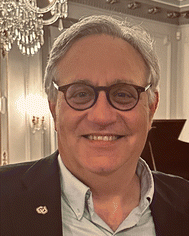Reflections from Seth Marder on 10 years of Materials Horizons
Seth R
Marder
abcd
aDepartment of Chemistry, University of Colorado Boulder, Boulder, USA. E-mail: seth.marder@colorado.edu
bRenewable and Sustainable Energy Institute, University of Colorado Boulder, Boulder, USA
cNational Renewable Energy Laboratory, Chemistry and Nanoscience Center, Golden, USA
dDepartment of Chemical and Biological Engineering, University of Colorado Boulder, Boulder, USA
In 2012, during my tenure as the Chair of the Editorial Board of the Journal of Materials Chemistry, Managing Editor Liz Dunn and I began discussing the idea to create a new materials journal within the Royal Society of Chemistry portfolio. When we reached out to colleagues for their thoughts, a typical first question was along of the lines of “why does the community need another materials journal and what would distinguish this journal from others?”
Our answers were relatively simple given the landscape at the time, which I will share with my personal bias.
Changing the way people think
I wanted to help create a broad and inclusive journal where people could introduce new concepts for materials. It was my sense that too many papers I had read in other high-quality journals were more predicated on an improvement in some property and less on changing how people think—i.e., providing a new conceptual approach or much deeper understanding. Thus, in this new journal, central to the paper being accepted would be the requirement of a clear articulation of a new conceptual advance.Value to the entire community
As one who considers himself an educator first, and a researcher second, I wanted the journal to be of value to early career scientists. For that reason, we made a conscious effort to include papers geared towards educating, in particular with our explanatory “Focus articles” aiming to address common misconceptions or explain complex topics. The first of these was “Mind the Gap” by my friend and colleague Jean-Luc Brédas and which has been cited ∼1000 times. In addition to our review articles, we wanted authors to be mindful that all papers be broadly accessible to a wide audience.Diverse leadership
I was frankly dissatisfied with the gender make-up of editors on Editorial and Advisory Boards at many chemistry and materials journals and felt we had the opportunity to provide a level of leadership in this regard and I was committed to doing so. I also felt that there were many mid-career scientists who may not have been quite as well-known as some of their very senior colleagues at the time but who were excellent researchers, would provide fresh perspectives and I was confident that they would become the next generation of leaders. As such we created a diverse Editorial Board and set of Scientific Editors. I will note that our view was not universally embraced, and some colleagues pushed back on our choices, but Liz and I felt that this was not an area where we would compromise, and our viewpoint prevailed. Now, 10-years later, it is clear that our guiding principles and the specific choices we made were correct.Young voices
In a similar vein, at that time the vast majority of input for shaping editorial policy of journals came from people whose average age was likely over 45 (perhaps significantly older), whereas the vast majority of the people reading the journals (students, postdoctoral researchers) were clearly younger. To me, this made no sense whatsoever and therefore shortly after Materials Horizons launched, Liz and I advocated for the creation of a Community Board of very early career scientists (graduate students, postdoctoral researchers and Assistant Professors embarking on their career), so that we could actively seek and act upon their input. At the time there was little precedent for this in most journals, but we made the case to the Royal Society of Chemistry publishing leadership, and they supported it (and emulated the approach in other Royal Society of Chemistry journals). This was, in my view, an excellent decision for many reasons – it sent a message to the community about what we valued, it gave the Community Board members exposure and experience, but most importantly, the engagement and depth of thought provided by our Community Board was hugely insightful.As I look back on my personal journey with Materials Horizons, I feel that to a very large extent the journal has lived up to our guiding principles and has been a valuable addition to the materials community. I hope, along the way, that some of what I described above made a difference for our readers and perhaps provided a model for other journals. What I can say, without doubt, is at a personal level having the opportunity to work with the Royal Society of Chemistry team and the entire Materials Horizons community was a privilege. I learned many things from many people and made good friends. Today, with Martina Stenzel leading the journal and with an incredible editorial board and Royal Society of Chemistry team, I am confident that Materials Horizons will not only live up to the ideals we had when it was created but it will continue to grow, adapt, and improve so that it can better serve the community.
Thanks to the Royal Society of Chemistry for entrusting me with the role of founding Chair of the Editorial Board, thank you to all the Advisory Board members, Community Board members and Scientific Editors. But most of all, thanks to you, the materials community, for your support of the journal. All we could do is create a platform for you, but it was truly you who helped to make Materials Horizons the excellent journal it is today.
Seth Marder
Inaugural Editorial Board Chair, 2013–2021
| This journal is © The Royal Society of Chemistry 2023 |

